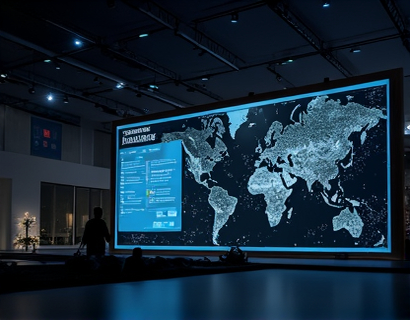Next-Gen QR Code Technology: Elevating Business Engagement and Social Media Interaction for Modern Enterprises
In the rapidly evolving digital landscape, businesses and social media managers are constantly seeking innovative solutions to enhance engagement and interaction. One such technology that has emerged as a game-changer is next-generation QR code technology. This advanced form of QR codes is not just an improvement over the traditional version but a complete reimagining designed to meet the complex needs of modern enterprises. These next-gen QR codes offer customizable and intuitive tools that streamline information sharing and significantly boost customer interaction, making them essential for brands looking to enhance their digital presence and foster deeper connections with their audience.
The evolution of QR codes from simple static images to dynamic, interactive tools reflects the broader trends in digital technology. Traditional QR codes were primarily used for basic tasks like directing users to websites or providing product information. However, next-gen QR codes go far beyond these limitations. They are designed to handle a wide range of data types, including text, URLs, images, videos, and even complex datasets. This versatility makes them an invaluable asset for businesses aiming to create rich, immersive experiences for their customers.
One of the key features of next-gen QR codes is their customizability. Unlike standard QR codes, which have a fixed appearance and limited functionality, next-gen QR codes can be tailored to fit specific brand identities and marketing strategies. Businesses can choose from a variety of colors, shapes, and sizes, allowing the QR code to seamlessly integrate into their visual branding. This level of customization not only enhances the aesthetic appeal but also ensures that the QR code stands out, increasing the likelihood of user interaction.
Another significant advantage of next-gen QR codes is their ability to provide real-time updates and dynamic content. Traditional QR codes once scanned, lead to a static URL that does not change. In contrast, next-gen QR codes can be linked to content management systems, enabling businesses to update the linked information without the need to reprint the QR code. This dynamic capability is particularly useful for promoting time-sensitive offers, sharing live event updates, or providing the latest product information. It ensures that the content remains fresh and relevant, keeping customers engaged and informed.
The integration of next-gen QR codes with digital platforms and social media is another area where they excel. Social media managers can use these QR codes to drive traffic to their profiles, share behind-the-scenes content, or create interactive campaigns. For instance, a QR code placed on a product package can direct users to a dedicated social media page where they can engage with the brand, leave comments, or participate in contests. This direct link between physical and digital spaces enhances the overall customer experience and encourages more meaningful interactions.
Moreover, next-gen QR codes are optimized for various devices and environments. They are designed to be easily scannable on smartphones and tablets, even in low-light conditions or when the code is partially obscured. This robustness ensures that users can access the linked content without frustration, thereby improving the overall user experience. The technology behind these QR codes also supports error correction, meaning that even if the code is damaged or scanned incorrectly, the system can still retrieve the correct information.
From a technical standpoint, next-gen QR codes utilize advanced encoding methods to maximize the amount of data they can store. This is particularly beneficial for businesses that need to share detailed information without overwhelming the user with too much text. For example, a QR code can encode a long URL, a large image, or even a short video, all within a small, visually appealing format. This efficiency not only saves space but also enhances the visual appeal of the QR code, making it more likely to be used and shared.
In the context of business engagement, next-gen QR codes can be strategically placed in various touchpoints to drive customer interaction. In retail environments, they can be used on product packaging, in-store displays, or even on receipts to provide additional information or promotional offers. In the hospitality industry, QR codes can be placed on hotel room keys or menus to offer guests access to local attractions, special deals, or digital concierge services. These applications not only enhance the customer experience but also provide businesses with valuable data on customer preferences and behaviors.
For businesses in the service sector, next-gen QR codes can serve as powerful tools for appointment reminders, service guides, and feedback collection. For instance, a QR code on a business card can direct the recipient to a digital version of the card, complete with contact information, a virtual business card holder, and links to the company’s social media profiles. This not only simplifies the exchange of contact information but also provides a seamless way for the recipient to engage with the business online.
In the realm of events and marketing, next-gen QR codes play a crucial role in enhancing attendee experiences. Event organizers can use these codes to create interactive maps, provide real-time schedules, and offer exclusive content to attendees. For example, a QR code at an exhibition booth can lead to a virtual demo of a product, a video testimonial, or a special discount offer. This level of interactivity not only keeps attendees engaged but also increases the likelihood of converting visitors into customers.
Furthermore, next-gen QR codes can be integrated with customer relationship management (CRM) systems to gather and analyze data on customer interactions. By tracking which QR codes are scanned and how users interact with the linked content, businesses can gain valuable insights into customer preferences and behavior patterns. This data can then be used to refine marketing strategies, personalize communications, and improve overall customer satisfaction.
The environmental impact of next-gen QR codes is another area worth considering. Traditional marketing materials often involve the production of paper flyers, brochures, and other printed content, which can contribute to waste and environmental degradation. Next-gen QR codes, on the other hand, can replace many of these physical materials with digital alternatives. By directing users to online content via a QR code, businesses can reduce their paper usage and carbon footprint, aligning with growing consumer demands for sustainable practices.
In addition to these practical benefits, next-gen QR codes also offer creative possibilities for brands. They can be used in innovative campaigns that blend the physical and digital worlds, creating memorable and shareable experiences. For example, a fashion brand could create a series of QR codes that, when scanned, reveal augmented reality (AR) fashion shows, virtual try-ons, or designer interviews. Such immersive experiences not only captivate the audience but also generate buzz and social media shares, amplifying the brand’s reach.
The future of next-gen QR code technology is promising, with ongoing developments in areas such as blockchain integration and enhanced security features. Blockchain technology can be used to create tamper-proof QR codes that ensure the authenticity and integrity of the linked content. This is particularly important for industries where trust and verification are critical, such as pharmaceuticals, luxury goods, and financial services. Enhanced security measures also protect against fraud and ensure that users have a safe and reliable experience when interacting with QR codes.
As businesses continue to navigate the complexities of the digital age, next-gen QR code technology stands out as a versatile and powerful tool for enhancing engagement and interaction. By leveraging the customizable, dynamic, and multi-functional nature of these QR codes, businesses can create more meaningful connections with their audience, drive higher conversion rates, and build a stronger digital presence. Whether it’s through targeted marketing campaigns, interactive customer experiences, or data-driven insights, next-gen QR codes offer a comprehensive solution for modern enterprises looking to stay ahead of the curve.










































